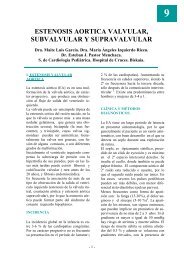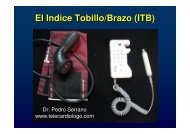Guidelines and Standards for Performance of a Pediatric ...
Guidelines and Standards for Performance of a Pediatric ...
Guidelines and Standards for Performance of a Pediatric ...
You also want an ePaper? Increase the reach of your titles
YUMPU automatically turns print PDFs into web optimized ePapers that Google loves.
Journal <strong>of</strong> the American Society <strong>of</strong> Echocardiography<br />
1414 Lai et al December 2006<br />
Congenital Heart Disease: History, Symptoms,<br />
<strong>and</strong> Signs<br />
Indications <strong>for</strong> the per<strong>for</strong>mance <strong>of</strong> a pediatric echocardiogram<br />
span a wide range <strong>of</strong> symptoms <strong>and</strong><br />
signs, including cyanosis, failure to thrive, exerciseinduced<br />
chest pain or syncope, respiratory distress,<br />
murmurs, congestive heart failure, abnormal arterial<br />
pulses, or cardiomegaly. These may suggest categories<br />
<strong>of</strong> structural congenital heart disease including<br />
intracardiac left-to-right or right-to-left shunts, obstructive<br />
lesions, regurgitant lesions, transposition<br />
physiology, abnormal systemic or pulmonary venous<br />
connections, conotruncal anomalies, coronary artery<br />
anomalies, functionally univentricular hearts,<br />
<strong>and</strong> other complex lesions, including abnormal laterality<br />
(heterotaxy/isomerism). Certain syndromes,<br />
family history <strong>of</strong> inherited heart disease, <strong>and</strong><br />
extracardiac abnormalities that are known to be<br />
associated with congenital heart disease constitute<br />
clinical scenarios <strong>for</strong> which echocardiography<br />
is indicated even in the absence <strong>of</strong> specific<br />
cardiac symptoms <strong>and</strong> signs. Abnormalities on<br />
other tests such as fetal echocardiography, chest<br />
radiograph, electrocardiogram, <strong>and</strong> chromosomal<br />
analysis constitute another group in which the<br />
suggestion <strong>of</strong> congenital heart disease is addressed<br />
specifically by echocardiography.<br />
Acquired Heart Diseases <strong>and</strong> Noncardiac<br />
Diseases<br />
An echocardiogram is indicated <strong>for</strong> the evaluation <strong>of</strong><br />
acquired heart diseases in children, including Kawasaki<br />
disease, infective endocarditis, all <strong>for</strong>ms <strong>of</strong><br />
cardiomyopathies, rheumatic fever <strong>and</strong> carditis, systemic<br />
lupus erythematosus, myocarditis, pericarditis,<br />
HIV infection, <strong>and</strong> exposure to cardiotoxic<br />
drugs. <strong>Pediatric</strong> echocardiography is indicated in the<br />
assessment <strong>of</strong> potential cardiac or cardiopulmonary<br />
transplant donors <strong>and</strong> transplant recipients. Recently,<br />
echocardiography has been recommended in<br />
all children who are newly diagnosed with systemic<br />
hypertension. 19 Noncardiac disease states that affect<br />
the heart such as pulmonary hypertension constitute<br />
an important indication <strong>for</strong> serial pediatric<br />
echocardiograms. Echocardiography may also be<br />
indicated in children with thromboembolic events,<br />
indwelling catheters <strong>and</strong> sepsis, or superior vena<br />
cava syndrome.<br />
Arrhythmias<br />
Children with arrhythmias may have underlying<br />
structural cardiac disease such as congenitally corrected<br />
transposition or Ebstein’s anomaly <strong>of</strong> the<br />
tricuspid valve, which may be associated with subtle<br />
clinical findings <strong>and</strong> are best evaluated using echocardiography.<br />
Sustained arrhythmias or antiarrhythmic<br />
medications may lead to functional perturbations<br />
<strong>of</strong> the heart that may only be detectable by<br />
echocardiography <strong>and</strong> have important implications<br />
<strong>for</strong> management.<br />
INSTRUMENTATION, PATIENT PREPARATION,<br />
AND PATIENT SAFETY<br />
Instrumentation<br />
Ultrasound instruments used <strong>for</strong> diagnostic studies<br />
should include, at a minimum, hardware <strong>and</strong> s<strong>of</strong>tware<br />
to per<strong>for</strong>m M-mode, 2D imaging, color flow mapping,<br />
<strong>and</strong> spectral Doppler studies, including pulsed wave<br />
<strong>and</strong> continuous wave capabilities. The transducers<br />
used in pediatric studies should provide adequate<br />
imaging across the wide range <strong>of</strong> depths encountered<br />
in pediatric cases. Multiple imaging transducers, ranging<br />
from low frequency (2-2.5 MHz) to high frequency<br />
(�7.5 MHz), should be available; a multifrequency<br />
transducer that includes all these frequencies is also an<br />
option. A transducer dedicated to the per<strong>for</strong>mance <strong>of</strong><br />
continuous wave Doppler studies should also be available<br />
<strong>for</strong> each study.<br />
The video screen <strong>and</strong> display should be <strong>of</strong> suitable<br />
size <strong>and</strong> quality <strong>for</strong> observation <strong>and</strong> interpretation <strong>of</strong> all<br />
the above modalities. The display should identify the<br />
parent institution, a patient identifier, <strong>and</strong> the date <strong>and</strong><br />
time <strong>of</strong> the study. The electrocardiogram should also<br />
be displayed in real time with the echocardiographic<br />
signal. Range or depth markers should be available on<br />
all displays. Measurement capabilities must be present<br />
to allow measurement <strong>of</strong> the distance between two<br />
points, an area on a 2D image, blood flow velocities,<br />
time intervals, <strong>and</strong> peak <strong>and</strong> mean gradients from<br />
spectral Doppler studies.<br />
Data Acquisition <strong>and</strong> Storage<br />
Echocardiographic studies must be recorded <strong>and</strong><br />
stored as moving images <strong>and</strong> must be stored on a<br />
medium that allows <strong>for</strong> playback <strong>of</strong> the recorded<br />
moving images. This would include videotape or<br />
digital recording media. It is unacceptable to store<br />
or archive moving echocardiographic images on a<br />
medium that displays only a static image, such as<br />
recording film or paper. Portions <strong>of</strong> the echocardiographic<br />
examination such as M-mode frames <strong>and</strong><br />
Doppler spectral measurements may be displayed<br />
<strong>and</strong> recorded as a static image on media appropriate<br />
to the laboratory situation.<br />
Patient Preparation <strong>and</strong> Safety<br />
Sufficient time should be allotted <strong>for</strong> each study according<br />
to the procedure type. The per<strong>for</strong>mance time<br />
<strong>of</strong> an uncomplicated, complete (imaging <strong>and</strong> Doppler)<br />
pediatric TTE examination is generally 45 to 60 minutes<br />
(from patient encounter to departure). Additional<br />
time may be required <strong>for</strong> complicated studies. All<br />
procedures should be explained to the patient <strong>and</strong>/or




